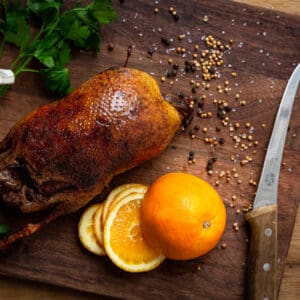Home » Small Game Cooking » Sous Vide Cooking Wild Ducks
Sous Vide Cooking Wild Ducks

Jack Hennessy grew up in the South Suburbs of Chicago…
Discover the secret to succulent wild duck with our recipe, designed to yield juicier meat compared to traditional methods that often result in dryness.
Recently, we covered how and why you should consider sous vide cooking your wild game. Now, let’s discuss the benefits of using a sous vide for a whole wild duck.
When I say whole wild duck, I mean any wild duck no larger than a male mallard. For this recipe, I used a greenhead that I aged for one week.
You can absolutely use this cooking method for pheasant meat or other upland birds. With this method, we walk a fine line between a well-done bird and tender, fully-cooked thighs and wings. While the breasts on a duck are best served at 130 degrees Fahrenheit, or medium rare, the legs need to get closer to 180 or 190 F before they’re done. At this point, the collagen has broken down and helped denature the meat.
With this recipe, it’s all about compromising between semi-tender legs and wings and semi-medium-ish breasts. Ultimately, we have a well-done wild duck and less-chewy thighs and wings. Despite this bird’s “well” nature, sealing in juices and using a low-temp setting on a sous vide will prevent this bird from drying out versus roasting in the oven.
If sous vide cooking birds smaller than a mallard or rooster, adjust the time in the sous vide accordingly. For example, a single quail only takes 1.5 hours at 152 Fahrenheit. If you’re asking yourself, “How did he make that skin crispy and brown using a sous vide?” The answer is I didn’t. I used a Schwank Grill heated to 1,500 Fahrenheit. First, I pulled that duck from the sous vide and patted it dry. Then, I used tongs to rotate the duck inside the Schwank Grill manually. My bird was crispy in under five minutes at the lowest heat setting. You can also use your oven’s broiler to crisp up bird skin post-sous vide.
Quick Time Guide to Sous Vide Birds
The following guide to cook times is at 152 F
- 4 hours for a mallard or rooster
- 3 hours for wood duck or ruffed grouse (or similarly sized bird)
- 2 hours for teal (or similarly sized bird)
- 1.5 hours for a single quail (or similarly sized bird)
- 1 hour for mourning dove

Sous Vide Duck Recipe
Equipment
Ingredients
- 1 whole wild mallard plucked
- Kosher salt and freshly cracked black pepper
- Whole honeycrisp apple (or similar) sliced
- 2 tbsp fresh garlic smashed
- 3 oz fresh ginger peeled and smashed
- 1 tbsp whole coriander
- 3-5 star anise
- 2 sprigs fresh thyme
- 2 sprigs fresh sage
- 1 sprig fresh rosemary
- Coarse sea salt
- thinly sliced orange for garnish
Instructions
- Liberally dust all sides of the plucked bird with kosher salt and freshly cracked black pepper, and let it sit uncovered in the fridge overnight.
- When you’re ready to sous vide, heat the sous vide water bath to 152 F. Seal the bird with the sliced apple, fresh herbs, coriander, star anise, ginger, and garlic.

- Sous vide cook for 4 hours at 152 F for a mallard or rooster, 3 hours for wood duck or ruffed grouse (or similarly sized bird), 2 hours for teal (or similarly sized bird), 1.5 hours for a single quail (or similarly sized bird), and 1 hour for mourning dove.
- When the bird is done, remove it from the sous vide bath when done. Cut open the sealed bag, remove any ingredients stuck to the bird, and pat the bird dry. Let it rest, uncovered, for 5 to 10 minutes while you heat the oven broiler or grill to HOT.
- Under the broiler or using a hot, hot, hot grill, crisp up the skin on all sides. Allow it to rest, uncovered, for 10 minutes before carving. Upon carving, you may wish to lightly sprinkle with coarse sea salt and set orange slices alongside the carved bird.

Notes
Nutrition
Jack Hennessy grew up in the South Suburbs of Chicago and didn't start hunting until he attended graduate school in Spokane, Washington, at the age of 26. Hennessy began work in professional kitchens in high school but didn't start writing wild game recipes until he joined the Spokesman-Review in 2014. Since then, his recipes have appeared with Petersen's Hunting, Backcountry Journal, Gun Dog Magazine, among many others. He now lives with his Wirehaired Vizsla, Dudley, in Wichita, Kansas.





